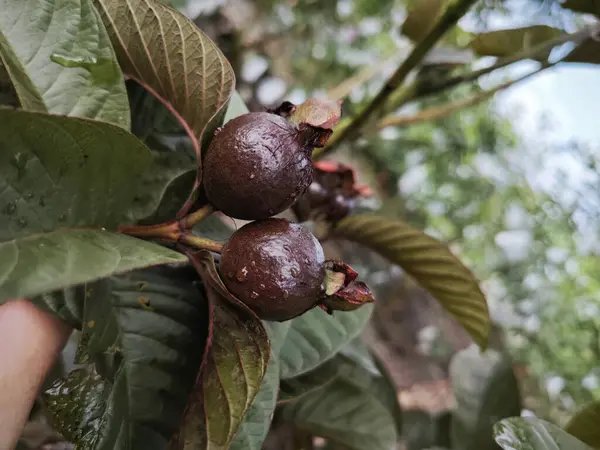Strawberry Guava - Botanical Information, Health and Various Uses
Let's explore the mulberry guava, learning about its botanical insights, growing and care, fruit harvesting and use, cultural significance and symbolism, as well as the health benefits associated with these special trees. Our goal is to equip you with a wealth of knowledge to help you appreciate and care for your mulberry guava trees.

Strawberry Guava - Botanical Facts and Properties
Background about the strawberry guava
The Cattley Guava (Psidium cattleianum) is an evergreen shrub or small tree native to the highlands of Brazil. It belongs to the Myrtaceae family, which includes other well-known species such as guava and feijoa. The tree is known for its small, delicious fruits that taste like strawberries. The tree is named "Cattley Guava" in English after the botanist William Cattley.
Features and growth pattern
Strawberry guava trees typically grow to a height of 2-5 meters, with an open, spreading canopy. The leaves are elliptical, dark green, and aromatic, releasing a delightful fragrance when crushed. The tree bears small, round or oval fruits that are 2-4 centimeters in diameter. These fruits mature to a variety of colors, including red, yellow, and purple, depending on the specific variety.
Flowers and pollen
The flowers of the mulberry guava are white, with prominent stamens, making them visually attractive. The tree is primarily self-pollinating, but it can also benefit from pollinators such as bees and butterflies, which improve fruit production.
Cultivation, growing and care of strawberry guava trees
To grow healthy strawberry guava trees, choose a location with full sun exposure. Proper soil preparation is essential, as these trees thrive in well-drained, slightly acidic soil. A pH level of 6.0-6.5 is ideal. Plant your trees about 3-4 feet apart to allow for adequate spacing.
Site selection and soil preparation
Choose a location that gets at least 6-8 hours of sunlight each day. Prepare the soil by loosening it to a depth of 30-40 centimeters and adding a layer of organic compost. This improves both drainage and nutrient retention.
Watering, fertilizing and mulching
Strawberry guava trees require consistent watering, especially during dry periods. A deep watering once a week is usually sufficient. Fertilizer should be added in early spring and again in late summer. Mulching (wood chips, for example) around the base of the tree helps retain soil moisture and suppress weed growth.
Pruning and pests
Pruning should be done to maintain the shape of the tree and to remove dead or diseased branches. Regular inspection is essential to identify and treat any potential pest or disease problems immediately using organic methods and materials.
Cultivation, growing and care of strawberry guava trees
Best practices for harvesting
The strawberry guava fruit is ripe when it changes color and becomes slightly soft. Twist or cut it gently from the tree, being careful not to damage the branches. It can be stored in the refrigerator for a few days.
Culinary uses
The fruits of the strawberry guava are prized for their sweet and aromatic flavor. They can be enjoyed fresh, added to fruit salads, used in jams, jellies and desserts. Their tropical flavor adds a unique dimension to various dishes.
Non-culinary applications
Beyond their delightful taste, the fruits can be used in cosmetic products, including perfumes and various natural skincare items, due to their pleasant aroma and antioxidant properties.
Cultural and symbolic significance of the mulberry guava tree
The strawberry guava has several symbolic meanings, including:
Resilience and Adaptability: This is a very hardy tree that can tolerate a wide range of conditions, including drought, flooding, and poor soil quality. This makes it a symbol of resilience and adaptability.
Abundance and Fertility: The mulberry guava is a prolific fruit producer, often bearing hundreds of fruits per tree. This makes it a symbol of abundance and fertility.
In Hawaiian culture, the deadly guava is known as waiawī, and is associated with the fertility goddess, Laka. The fruit is often used in local ceremonies.
Strawberry Guava - Health Benefits
Packed with essential vitamins and minerals, including vitamin C, vitamin A, and dietary fiber, strawberry guava fruit offers a refreshing and nutritious addition to your diet.
Consuming guava, strawberries, and other fruits is linked to many health benefits, such as an improved immune system, better digestion, and possible antioxidant effects.
Strawberry guava - did you know?
The tree got its name because of the unique strawberry-like flavor of the fruit.
This tree can thrive at altitudes of up to 1,500 meters above sea level.
Mulberry guava leaves are used in traditional medicine for their potential therapeutic properties.
Summary
In conclusion, mulberry guava trees, scientifically known as Psidium cattleianum, are a great addition to any garden or orchard. From their unique botanical characteristics to the delightful fruits they produce, these trees offer a world of beauty, flavor, and cultural significance. By understanding how to properly care for them, you can enjoy these unique trees and their many benefits. We hope this guide has equipped you with the knowledge you need to nurture, cherish, and enjoy your tree!

_page-0001_edited.png)